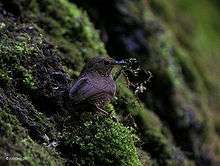Pnoepyga
| Pnoepyga | |
|---|---|
 | |
| Scaly-breasted wren-babbler | |
| Scientific classification | |
| Kingdom: | Animalia |
| Phylum: | Chordata |
| Class: | Aves |
| Superorder: | Neognathae |
| Order: | Passeriformes |
| Suborder: | Oscines |
| Infraorder: | Passerida |
| Superfamily: | Sylvioidea |
| Family: | Pnoepygidae |
| Genus: | Pnoepyga Hodgson, 1844 |
Pnoepyga is a genus of passerines endemic to southern and south eastern Asia. Its members are known as wren-babblers or cupwings. The genus contains five species. The genus has long been placed in the babbler family Timaliidae. A 2009 study of the DNA of the families Timaliidae and the Old World warblers (Sylviidae) found no support for the placement of the genus in either family, prompting the authors to erect a new monogeneric family, the Pnoepygidae.[1]
This genus of diminutive passerines has a mostly montane distribution in South and South East Asia. The scaly-breasted wren-babbler or scaly-breasted cupwing is found in the mountainous areas of north India eastwards to southern China and northern Vietnam. The Taiwan wren-babbler or Taiwan cupwing is endemic to Taiwan, and similarly the Nepal wren-babbler or Nepal cupwing has a restricted distribution, mostly occurring in Nepal (and also slightly into India). The most widespread species is the pygmy wren-babbler or pygmy cupwing, which occurs from China and India south through Southeast Asia into the Malay Peninsula and Indonesia as far as Flores and Timor.[2]
Species
It contains the following species:
- Scaly-breasted wren-babbler or scaly-breasted cupwing (Pnoepyga albiventer (Hodgson, 1837))
- Taiwan wren-babbler or Taiwan cupwing (Pnoepyga formosana Ingram, W, 1909)
- Nepal wren-babbler or Nepal cupwing (Pnoepyga immaculata Martens, J & Eck, 1991)
- Pygmy wren-babbler or pygmy cupwing (Pnoepyga pusilla Hodgson, 1845)
- Chinese wren-babbler or Chinese cupwing (Pnoepyga mutica Thayer & Bangs, 1912)
References
- ↑ Gelang, Magnus; Cibois, Alice; Pasquet, Eric; Olsson, Urban; Alström, Per; Ericson, Per G. P. (2009). "Phylogeny of babblers (Aves, Passeriformes): major lineages, family limits and classification". Zoologica Scripta. 38 (3): 225–236. doi:10.1111/j.1463-6409.2008.00374.x.
- ↑ Collar, N. J. & Robson, C. 2007. Family Timaliidae (Babblers) pp. 70 - 291 in; del Hoyo, J., Elliott, A. & Christie, D.A. eds. Handbook of the Birds of the World, Vol. 12. Picathartes to Tits and Chickadees. Lynx Edicions, Barcelona.